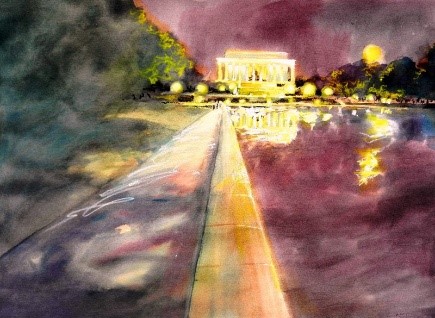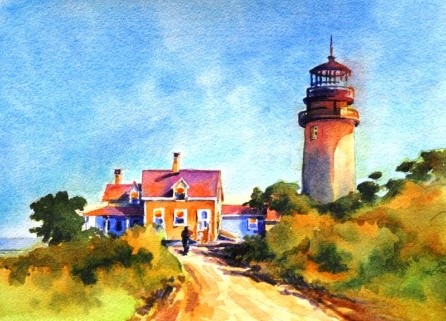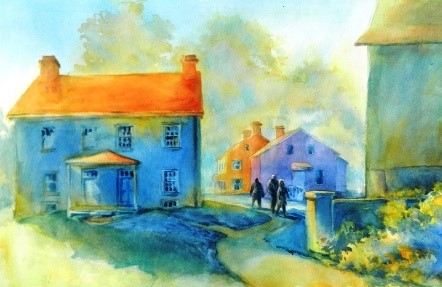Interested in an Original Painting?
Contact Virgil to inquire.
Interested in fine art prints and
more? Shop Fine Art America

"Hopper’s Light", watercolor, 15” X 11”
![]() 4 November 2025
4 November 2025
Today we conclude our current three part series of postings on the interrelated subjects of the three planes of vision, focal point/area of interest and depth. Today we examine creating depth in watercolor paintings. Depth is what transforms a flat wash into a captivating vista, inviting the viewer’s eye to wander through the layers of your painted world. Without depth, even the most vibrant paintings can feel static and two-dimensional.
When we translate a scene onto paper, capturing that sense of three-dimensionality is what breathes life into the artwork, making it feel more realistic, evocative, and emotionally resonant. Depth creates a sense of atmosphere, guiding the viewer’s focus and adding narrative to your piece. It allows you to suggest vast distances, intimate foregrounds, and the subtle recession of planes, ultimately enriching the visual experience


To create depth in watercolor paintings, artists may employ a combination of painting strategies. Here’s some key techniques:
1. Value and Contrast: This is arguably the most fundamental tool for creating depth. Maximize dark-light contrast, particularly in the most important focal areas and minimize it elsewhere, particularly in the background if the focal point is not located there. Preserve lightest values or white paper for highlights in selected important elements
2. Atmospheric Perspective (Aerial Perspective): This technique mimics how the atmosphere affects our perception of distant objects. Painting colors become cooler and less saturated; values are lighter; details soften and often disappear as shapes recede; and edges become less defined, softer or lost.
3. Overlapping: Placing shapes in front and behind one another is an effective technique to create visual depth. The size and scale of shapes appear smaller as they move further away from the viewer. Using linear perspective enhances the sense of depth.
4. Edge Variety: Using lost and found edges also contributes to depth, with shapes with sharp edges visually advancing, while softer and “lost” edges allow shapes to blend into the background.


Experimenting with these techniques and observing how they interact is key to developing compelling depth in watercolor paintings. There are many different approaches that can work with various painting styles and subject matter. Mastering the illusion of depth is a significant step in unlocking watercolor’s magical potential.
Is depth important to you when you look at and make watercolor paintings?
Contact Virgil to inquire.
more? Shop Fine Art America

“You Must Go Left or Right” , Watercolor, 30” X 11”